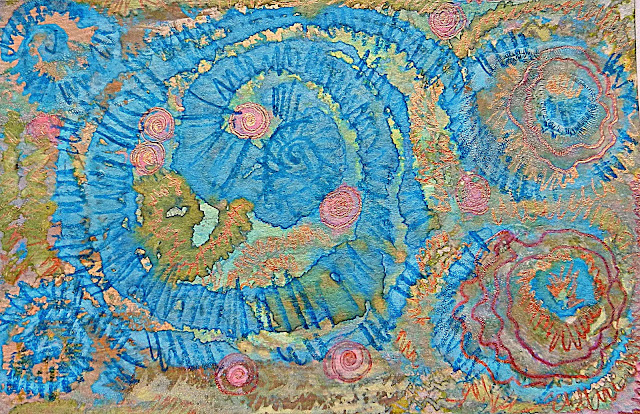“Repeat Motifs – Unique Finishes”
A 3-Day Intensive for Polymer Clay Surface Design
June
21-23, 2017
Join me this June for the 5th year of Art on the Farm, at my home studio in Braintree, Vermont, in the heart of rural New England. Our topic for the 3-day intensive workshop is "Repeat Motifs - Unique Finishes".
We'll start class by creating a simple signature motif, then learn how
to use textures, paints, pastels, acrylic mediums, alcohol inks, crayons and
much, much more to color and enhance these polymer elements with custom surfaces.
Since there are so many possibilities for surface embellishment, limiting ourselves to one unique shape will help us refine our technique and we’ll experiment with layered
forms, changing the proportions of our shapes and abstracting these motifs into multiple elements
to use for jewelry and mixed media projects.
Students have access to my extensive collection of
texture sheets, molds and stencils, as well as to all the paints, mediums,
inks and pastels in my studio. Believe me, I have tons of interesting
things to play with! Try out the newest Tim Holtz/Ranger® line of Distress and
Distress Oxide paints using my techniques for making these finishes
work even on non-porous polymer clay surfaces.
As one of the earliest adopters of surface techniques for
polymer clay, I have years of experience using paints, watercolors, pastels,
inks and other surface design media on opaque and translucent polymer clay. If you’ve ever wanted to delve
into the amazing world of coloring the surface of polymer, this is the workshop for
you! Small class size means lots of one-on-one time with the instructor. Beginners to polymer as well as those experienced in the medium are welcome, as these are not techniques that you'll find in books or online, so everyone starts at the same point. You'll go back to your home studio with all the information necessary to continue your own experiments in color and texture and stock up on the supplies you really want, after trying them out at the workshop.
If you're interested in the upcoming June workshop or the one later this Fall, October 4-6, 2017 leave a message on my website at http://www.storiestheytell.com with your e-mail address to check for spaces in class and for more information on tuition, lodging, etc.
Here are some examples of surfaces we'll learn how to do in class. Enjoy the eye candy!
Pan Pastels, acrylic paint, embedded wire
Pan Pastels, acrylic paint, graphite paint
Ranger Distress Paints, acrylic medium, alcohol inks
Ranger Distress Paints, acrylic paint, alcohol ink
"Colors of the Canyon" - Pan Pastels, micaceous iron oxide
Pan Pastels, acrylic paint
Acrylic paint, alcohol ink
"Homage to Tuscon" - Micaceous iron oxide, acrylic paint
"Kaleidescope" pendant - acrylic paint, Pan Pastels
"Landscape" earrings - Acrylic paint, Pan Pastels
"Molokai" earrings - Acrylic paint, Pan Pastels
Acrylic paint, handmade texture plates
"Oracle" earrings - Overlapped, repeating shapes;
Acrylic paint, Pan Pastels
Acrylic paint, layered shapes
Layered shapes, acrylic paint
Handmade texture plates; repeating, overlapping shapes, acrylic paint, Pan Pastels
"Samurai" pendant - Acrylic paint
"Sargasso" pendant - Handmade textures,
acrylic paint, Pan Pastels
"Sedona" pin/pendant - Acrylic paints, Pan Pastels
"Stone Circle" pendant - Pieced, sliced polymer with metallic paints and Pan Pastels
"Trojan" earrings - Layered and stacked forms,
acrylic paints, Pan Pastels
"Turquoise Landscape" pin/pendant - Pan Pastels
"
"Wabi Sabi" - pendant - Translucent liquid polymer, micaceous iron oxide, Pan Pastels, acrylic paint
"Wabi Sabi" - pendant - Translucent liquid polymer, micaceous iron oxide, Pan Pastels, acrylic paint













































